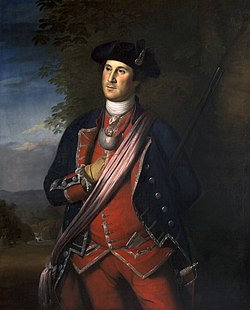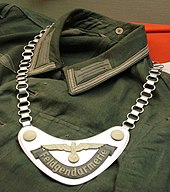Gorget
A gorget (/ˈɡɔːrdʒɪt/ GOR-jit; from the French gorge meaning 'throat') was a band of linen wrapped around a woman's neck and head in the medieval period or the lower part of a simple chaperon hood.
The term may also be used for other things such as items of jewellery worn around the throat region in several societies, for example wide thin gold collars found in prehistoric Ireland dating to the Bronze Age.
Some gorgets of this period were "parade" pieces that were beautifully etched, gilded, engraved, chased, embossed or enameled at great expense.
The Japanese (samurai) form of the gorget, called a nodowa, was either fastened by itself around the neck or came as an integral part of the face defence or men yoroi.
They were still worn to a limited extent in the Imperial German Army until 1914, as a special distinction by officers of the Prussian Gardes du Corps and the 2nd Cuirassiers "Queen".
Officers of the Spanish infantry continued to wear gorgets with the cypher of King Alfonso XIII in full dress, until the overthrow of the Monarchy in 1931.
During World War II, it continued to be used by Feldgendarmerie (military field police), who wore metal gorgets as emblems of authority.
German police gorgets of this period typically took the form of flat metal crescents with ornamental designs that were suspended by a chain worn around the neck.
With limited exceptions such as senior officers of the Army Medical and Dental Corps, the historic colour differentials are no longer worn in the British service.
[citation needed] Gorgets made of shell, as well as stone and copper,[12] have been found at archaeological sites of various ages associated with mound building cultures of Eastern North America, going back thousands of years.
[13] The British Empire awarded gorgets to chiefs of American Indian tribes, both as tokens of goodwill, and as a badge of their high status.
[16] In colonial Australia, gorgets were given to Aboriginal people by government officials and pastoralists as insignia of high rank or reward for services to the settler community.
Frequently inscribed with the word "King" along with the name of the tribal group to which the recipient belonged (despite the absence of this kind of rank among indigenous Australians), the "breastplates", as they came to be known, were highly regarded by those who received them.







